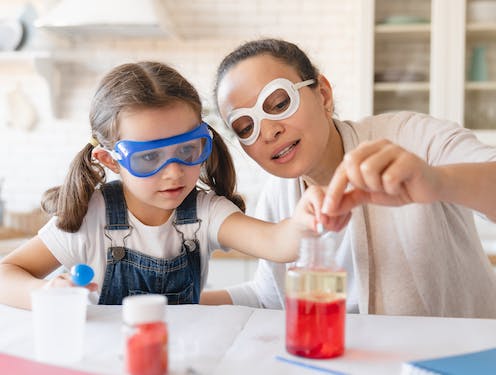Inside Creative House/Shutterstock
The school summer holidays are in full swing. If you’re a parent, you may be getting tired of hearing “I’m bored!” echoing through your home – especially on rainy days when everyone’s stuck inside.
But pretty much every kitchen can double as a chemistry set. Here are some experiments to try at home with your school-age children, using things you’ll be able to find around your home.
Make bubbles stop in mid-air
You can make bubbles hang in mid-air by creating a layer of carbon dioxide in a bowl for them to float on.
First of all, you’ll need some bubble mixture and a wand. You might already have some shop-bought bubbles at home, or you can make a bubble mixture by adding one part of washing-up liquid to six parts of water. You can make a bubble wand by twisting the end of a piece of wire into a circle.
Then it’s time to create carbon dioxide – a gas made up of atoms of carbon and oxygen. Carbon dioxide is denser than air, so it will sit in the bottom of a bowl as long as there are no air currents that will blow it away.
Note: breathing in air containing too much carbon dioxide is dangerous. This experiment is unlikely to produce enough to be dangerous, however, unless you put your face in the bowl full of the gas.
To make carbon dioxide, you’ll need to mix together some acid and a carbonate. Minerals such as limestone and marble are carbonates, all of which produce carbon dioxide when mixed with acid. Use some vinegar from your store cupboard as the acid, while baking soda, baking powder or washing soda will work as the carbonate.
Put some of your baking soda or other carbonate into a bowl with fairly tall sides, such as a washing-up bowl or large mixing bowl. Two or three level tablespoons should be enough for a reasonably sized washing up bowl.
This needs to be put where the air is still, so that draughts don’t blow the carbon dioxide away. Then pour in about 200ml of vinegar. The mixture will fizz: this means a gas – carbon dioxide – is being produced. Once the reaction has started, try not to disturb the bowl or the air around it too much, otherwise the carbon dioxide will blow away.
Now it’s time to make your bubbles float. Use your bubble mixture and wand to blow bubbles into the bowl. If you have a thick enough layer of carbon dioxide, when the bubbles reach it they will stop in mid-air: floating on it just like a piece of wood floats on water. The air in the bubble is less dense than the carbon dioxide so the bubble floats, just like wood (which is less dense than water) floats on water.
Dissolve an egg shell
You’ll need vinegar again for this experiment, this time to make an egg shell dissolve. Eggs are protected by shells made from another kind of carbonate: calcium carbonate.
If you put an egg in a glass jar or jug and cover it in vinegar, over a few hours the shell will slowly dissolve. This is because – just like the sodium bicarbonate in our first experiment – the calcium carbonate reacts with vinegar, breaking down into carbon dioxide and a substance called calcium acetate.
It would be best to leave your egg and vinegar experiment overnight as the reaction can be rather slow. After some hours, the shell will have at least partially dissolved and what is left can be rubbed off – but be gentle. You now have a somewhat bouncy egg!
Grow sugar crystals
The sugar we use in food is made of tiny crystals. With a little patience, you can use sugar to grow much larger, pretty and colourful crystals.
Start by heating some water until it is sufficiently warm to dissolve the sugar quickly. Then, put the water in a bowl and start adding spoonfuls of sugar, stirring so that the sugar dissolves. Keep going until no more sugar will dissolve.
You might be surprised at how much sugar it takes to get to this point. A typical recipe is three parts sugar to one part water. If you want to make your crystals colourful, add a few drops of food colouring. But remember that a little food colouring goes a long way!
Pour the mixture into a glass jar, so you can watch the crystals grow over time. Put a bamboo kebab skewer or cocktail stick into the jar, or hang a piece of string over the edge down into the mixture. This will give the crystals a place to start growing.
Now put your jar somewhere it can sit undisturbed. As the water in your solution evaporates, the sugar solution becomes more concentrated. At some point, there will not be enough water to dissolve all the sugar, and that’s when the crystals start to form.
The slower the water evaporates, the larger the crystals will grow. Big crystals might take several days to grow. If you are impatient and keep your water in a warm place, the water will evaporate more quickly, but the crystals will end up smaller.
![]()
Stephen Ashworth occasionally receives funding from bodies such as The Royal Society of Chemistry through a number of different routes to pursue my Kitchen Chemistry Science Shows. I have also been funded by my institution to carry out these science shows internationally.
The Kitchen Chemistry Outreach Project is a sole trader business that has charitable goals.
This article is based on the material I have used, adapted and developed for those science shows. I am disclosing in the interests of full transparency.











